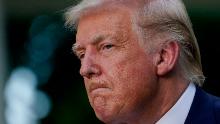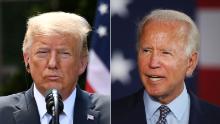[ad_1]
Their aim — in keeping with the President’s relentless push to reopen the US economy regardless of the human cost — is to get Americans to focus on anything other than the raging virus while distracting from the administration’s flawed effort to control it earlier this year, a diversionary tactic that has not worked so far.
After aggressive race-baiting earlier this summer, the Trump team is pivoting with greater focus to the longtime GOP tactic of trying to paint their Democratic opponent as weak and ill-equipped to protect and defend America.
Pence on the stump
Distilling the Trump campaign’s argument in Ripon, Wisconsin, on Friday, Pence described Biden as something akin to a zombie candidate who had been co-opted by Vermont Sen. Bernie Sanders and the radical left, and falsely claimed that Biden is now aligned with far-left activists who want to defund the police.
While scarcely mentioning the human toll of the coronavirus, Pence charged that Biden and Sanders have embraced an agenda based on government control that would be defined by “an avalanche of regulation,” “open borders” and hostility toward police.
With that comment, Pence said Biden had “capitulated to the radical left-wing mob.”
“Joe Biden would weaken the Thin Blue Line that separates order from chaos,” Pence said, noting that the Trump administration would never defund the police. “We will defend the police every day. … The hard truth is: you won’t be safe in Joe Biden’s America.”
Trump echoed those comments in a tweet Friday night: “Corrupt Joe Biden wants to defund our police. He may use different words, but when you look at his pact with Crazy Bernie, and other things, that’s what he wants to do. It would destroy America!”
Reprising an unproven argument
Employing tired racial tropes that were used in the previous century — and that seem wildly out of step with the views of most Americans today — Trump claimed that under the rule, homes will “go down in value and crime rates will rapidly rise… Suburbia will be no longer as we know it.”
But there is scant evidence that Trump’s tactics of fear and racial division are working. This week brought another poll showing Biden leading Trump by double digits, as his coronavirus performance still appears to be a major driver in his approval ratings.
In an average of recent ABC News/Ipsos and Quinnipiac polls, Trump’s approval rating on coronavirus among Whites without a college degree was about 50% and the numbers were similar among rural voters, Enten noted.
And as much as Trump and Pence would like to shift the conversation away from the coronavirus, it is still top of mind for Americans as the US shattered yet another record Thursday with more than 77,000 new Covid-19 cases.
The trust gap for the President when it comes to Covid-19 is glaring: a stunning 64% said they trust “not much” or nothing at all of what Trump says about the pandemic.
Lack of leadership
The administration’s moves to suppress public information about the spread of Covid-19 certainly will not help rebuild voter confidence. The Trump administration’s decision directing hospitals to bypass the US Centers for Disease Control and Prevention and send their data directly to the Department of Health and Human Services met a furious backlash from public health experts this week.
“No one is taking access or data away from CDC,” Redfield said.
Devin O’Malley, spokesman for Pence and the task force, said the report showed “encouraging signs” amid the pandemic, because a few weeks ago Pence reported that “16 states met the criteria for rising cases and rising positivity rate.” In the unpublished report, he noted that only 10 states fit that criteria. “This is just one data point of many encouraging signs that we are seeing across the country as we continue to respond to the coronavirus pandemic,” O’Malley said in a statement to CNN.
But as many times as Trump and Pence try to claim that America is moving on from the virus and that everything is fine, the data continues to tell another story.
“People say is this a second wave? No. We’re still in the first one,” Dr. Francis Collins, director of the National Institutes of Health, told CNN’s Wolf Blitzer on “The Situation Room” Friday evening.
“It never quite went away,” after the major outbreaks in March and April, Collins said, “and now it’s coming back in a very steep incline, which is, of course, a source of great concern for anybody, especially in those hard-hit areas.”
[ad_2]
Source link





